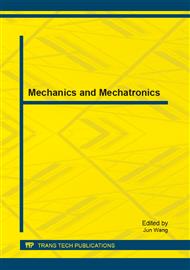[1]
M. Bornitz, H. -J. Hardtke, and T. Zahnert, Evaluation of implantable actuators by means of a middle ear simulation model, Hearing Research. 263(1) (2010) 145-151.
DOI: 10.1016/j.heares.2010.02.007
Google Scholar
[2]
R.Z. Gan, C. Dai, X. Wang, D. Nakmali, et al., A totally implantable hearing system–Design and function characterization in 3D computational model and temporal bones, Hearing Research. 263(1) (2010) 138-144.
DOI: 10.1016/j.heares.2009.09.003
Google Scholar
[3]
X. Wang, Y. Hu, Z. Wang, and H. Shi, Finite element analysis of the coupling between ossicular chain and mass loading for evaluation of implantable hearing device, Hearing research. 280(1) (2011) 48-57.
DOI: 10.1016/j.heares.2011.04.012
Google Scholar
[4]
H. Liu, Z. Rao, and N. Ta, Finite element analysis of the effects of a floating mass transducer on the performance of a middle ear implant, Journal of Medical Engineering & Technology. 34(5-6) (2010) 316-323.
DOI: 10.3109/03091902.2010.481033
Google Scholar
[5]
Q. Sun, K. -H. Chang, K.J. Dormer, R.K. Dyer Jr, et al., An advanced computer-aided geometric modeling and fabrication method for human middle ear, Medical engineering & physics. 24(9) (2002) 595-606.
DOI: 10.1016/s1350-4533(02)00045-0
Google Scholar
[6]
Q. Sun, R. Gan, K. -H. Chang, and K. Dormer, Computer-integrated finite element modeling of human middle ear, Biomechanics and Modeling in Mechanobiology. 1(2) (2002) 109-122.
DOI: 10.1007/s10237-002-0014-z
Google Scholar
[7]
R.Z. Gan, Q. Sun, B. Feng, and M.W. Wood, Acoustic–structural coupled finite element analysis for sound transmission in human ear—Pressure distributions, Medical engineering & physics. 28(5) (2006) 395-404.
DOI: 10.1016/j.medengphy.2005.07.018
Google Scholar
[8]
T. Koike, H. Wada, and T. Kobayashi, Modeling of the human middle ear using the finite-element method, The Journal of the Acoustical Society of America. 111 (2002) 1306.
DOI: 10.1121/1.1451073
Google Scholar
[9]
J.P. Tuck-Lee, P.M. Pinsky, C.R. Steele, and S. Puria, Finite element modeling of acousto-mechanical coupling in the cat middle ear, The Journal of the Acoustical Society of America. 124 (2008) 348.
DOI: 10.1121/1.2912438
Google Scholar
[10]
R. Aibara, J.T. Welsh, S. Puria, and R.L. Goode, Human middle-ear sound transfer function and cochlear input impedance, Hearing research. 152(1) (2001) 100-109.
DOI: 10.1016/s0378-5955(00)00240-9
Google Scholar
[11]
S. Puria, W.T. Peake, and J.J. Rosowski, Sound-pressure measurements in the cochlear vestibule of human-cadaver ears, The Journal of the Acoustical Society of America. 101 (1997)2754.
DOI: 10.1121/1.418563
Google Scholar
[12]
H.H. Nakajima, W. Dong, E.S. Olson, S.N. Merchant, et al., Differential intracochlear sound pressure measurements in normal human temporal bones, Journal of the Association for Research in Otolaryngology. 10(1) (2009) 23-36.
DOI: 10.1007/s10162-008-0150-y
Google Scholar
[13]
H.H. Nakajima, S.N. Merchant, and J.J. Rosowski, Performance considerations of prosthetic actuators for round-window stimulation, Hearing research. 263(1) (2010) 114-119.
DOI: 10.1016/j.heares.2009.11.009
Google Scholar
[14]
R.Z. Gan, B.P. Reeves, and X. Wang, Modeling of sound transmission from ear canal to cochlea, Annals of biomedical engineering. 35(12) (2007) 2180-2195.
DOI: 10.1007/s10439-007-9366-y
Google Scholar
[15]
Z. Wang,X. Wang, Y. Hu, H. Shi, et al., FEM Simulation of Sound Transmission Based on Integrated Model of Middle Ear and Cochlea, Chinese Journal of Biomedical Engineering. 30(001) (2011)60-66.
Google Scholar
[16]
X. Nie, H. Liu, X. Huang, J. Tan, et al., Finite element model of human ear reconstruction through micro-computer tomography, Acta oto-laryngologica. 131(3) (2011) 269-276.
DOI: 10.3109/00016489.2010.542487
Google Scholar
[17]
C.F. Lee, P.R. Chen, W.J. Lee, J.H. Chen, et al., Three-Dimensional Reconstruction and Modeling of Middle Ear Biomechanics by High-Resolution Computed Tomography and Finite Element Analysis, The Laryngoscope. 116(5) (2006) 711-716.
DOI: 10.1097/01.mlg.0000204758.15877.34
Google Scholar
[18]
N. Kim, K. Homma, and S. Puria, Inertial bone conduction: symmetric and anti-symmetric components, Journal of the Association for Research in Otolaryngology. 12(3)(2011) 261-279.
DOI: 10.1007/s10162-011-0258-3
Google Scholar
[19]
C.R. Steele and K. -M. Lim, Cochlear model with three-dimensional fluid, inner sulcus and feed-forward mechanism, Audiology and Neurotology. 4(3-4)(1999) 197-203.
DOI: 10.1159/000013841
Google Scholar
[20]
M. Thorne, A.N. Salt, J.E. DeMott, M.M. Henson, et al., Cochlear Fluid Space Dimensions for Six Species Derived From Reconstructions of Three-Dimensional Magnetic Resonance Images, The Laryngoscope. 109(10) (1999) 1661-1668.
DOI: 10.1097/00005537-199910000-00021
Google Scholar
[21]
I. Teudt, S. McCusker, and C. Richter. Basilar membrane and tectorial membrane stiffness in CBA/Caj mice. in ARO—Midwinter meeting. (2007).
DOI: 10.1007/s10162-014-0463-y
Google Scholar
[22]
R.Z. Gan, M.W. Wood, and K.J. Dormer, Human middle ear transfer function measured by double laser interferometry system, Otology & Neurotology. 25(4)(2004) 423-435.
DOI: 10.1097/00129492-200407000-00005
Google Scholar
[23]
A. Arnold, M. Kompis, C. Candreia, F. Pfiffner, et al., The floating mass transducer at the round window: Direct transmission or bone conduction? Hearing Research. 263(1)(2010) 120-127.
DOI: 10.1016/j.heares.2009.12.019
Google Scholar
[24]
S.N. Merchant, M.E. Ravicz, and J.J. Rosowski, Acoustic input impedance of the stapes and cochlea in human temporal bones. Hearing research. 97(1) (1996) 30-45.
DOI: 10.1016/s0378-5955(96)80005-0
Google Scholar
[25]
T. Gundersen, ø. Skarstein, and T. Sikkeland, A study of the vibration of the basilar membrane in human temporal bone preparations by the use of the Mossbauer effect, Acta Oto-Laryngologic. 86(1-6)(1978) 225-232.
DOI: 10.3109/00016487809124740
Google Scholar
[26]
S. Stenfelt, S. Puria, N. Hato, and R.L. Goode, Basilar membrane and osseous spiral lamina motion in human cadavers with air and bone conduction stimuli, Hearing research. 181(1)(2003) 131-143.
DOI: 10.1016/s0378-5955(03)00183-7
Google Scholar
[27]
D.D. Greenwood, A cochlear frequency-position function for several species-29 years later, The Journal of the Acoustical Society of America. 87 (1990) 2592.
DOI: 10.1121/1.399052
Google Scholar


